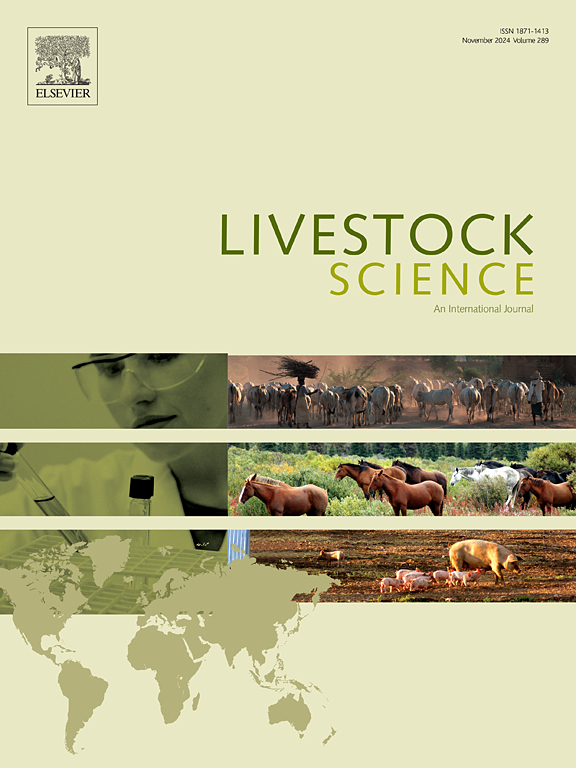尼洛尔肉牛小母牛早期妊娠候选基因的鉴定和基因组预测
IF 1.9
3区 农林科学
Q2 AGRICULTURE, DAIRY & ANIMAL SCIENCE
引用次数: 0
摘要
本研究旨在利用单步基因组BLUP模型(ssGBLUP),评估携带候选因果位点的基因组区域的不同权重对内洛尔(Bos indicus)小母牛早期妊娠(产犊至30月龄的小母牛)预测准确性和膨胀率的影响。本研究使用了 2010 年至 2017 年间出生的 102 294 头内洛尔母牛的表型记录。血统数据集包含 1998 年至 2017 年间出生的 176107 头牲畜的信息,其中包括 5145 头公牛和 35705 头母牛。通过结合加权单步 GWAS(sww1GBLUP 和 ssw2GBLUP)迭代(第 1 次和第 2 次)中获得的 SNP 权重或文献中报道的候选 QTL,定义了七种不同的基因组预测模型。因此,在 WssGWAS 中估算的 lambda (λ) 值被用于加权与候选区域或先前在文献中报道的 QTL 相邻的 SNPs。为了估计遗传参数并对小母牛早期妊娠进行 WssGWAS 和 WssGBLUP,使用了考虑阈值动物模型的单性状贝叶斯分析。根据线性回归(LR)方法对验证子集的准确性、偏差和膨胀参数进行了评估。选取了解释了0.5%加性遗传变异的十个连续SNP的基因组窗口,以探索和确定可能的候选基因。在确定的基因中,我们可以重点关注 PGRMC2、TENM3、GRIP1、TMEM45A 和 KLF3,因为它们在内分泌繁殖力、收缩蛋白的表达、平均日增重、干物质摄入量和脂肪沉积中发挥作用。与小母牛早期妊娠有关的 QTL 相关的几个基因组区域已被确定。确定这些区域以及与性早熟和繁殖力相关的候选基因将有助于提高内洛尔牛早期性早熟的遗传知识。与 BLUP 模型相比,ssGBLUP 的预测准确率提高了约 25.6%。在 WssGWAS 第 1 次(ssw1GBLUP)和第 2 次迭代(ssw2GBLUP)中获得的 λ 值加权 SNP 纳入 WssGBLUP 时,其预测准确率比 ssGBLUP 模型高(∼18%)。膨胀还增加了通过 GWAS 获得的最相关 SNP 的权重,很可能会高估 GEBV。与 ssw1GBLUP 和 ssw2GBLUP 模型相比,对接近文献中报告的 QTL 的 SNPs 进行加权的模型得出的预测结果偏差较小,膨胀也较小。基因组选择是内洛尔肉牛早期小母牛妊娠基因组评估的一种可行替代方法,它能提高幼畜的预测准确性。此外,使用从 WssGWAS 中获得的信息也是提高可靠性和减少基因组预测偏差的一种替代方法。因此,本文得出的结果表明,通过使用基因组信息和先前文献中报道的小母牛早期妊娠候选 QTLs 的不同加权基因组区域,可以提高预测准确性并减少基因组预测偏差。本文章由计算机程序翻译,如有差异,请以英文原文为准。
Identification of candidate genes and genomic prediction for early heifer pregnancy in Nelore beef cattle
This study aimed to assess the influence of differential weighting in genomic regions harboring candidate causal loci on the prediction accuracy and inflation for early heifer pregnancy (heifers that calved up to 30 months of age) in Nellore (Bos indicus) heifers using the single step genomic BLUP model (ssGBLUP). Phenotypic records of 102,294 Nellore heifers born between 2010 and 2017 were used in this study. The pedigree dataset harbored information from 176,107 animals born between 1998 and 2017, including 5,145 sires and 35,705 dams. Seven different models for genomic prediction were defined by combining the SNP weights obtained in the iterations (1st and 2nd) of the weighted single step GWAS (ssw1GBLUP and ssw2GBLUP) or candidate QTLs reported in the literature. Hence, the lambda (λ) values estimated in the WssGWAS were used to weight the SNPs adjacent to the candidate regions or QTL previously reported in the literature. To estimate the genetic parameters and perform the WssGWAS and WssGBLUP for early heifer pregnancy, a single-trait Bayesian analysis considering a threshold animal model was used. Accuracy, bias, and inflation parameters were evaluated in the validation subset based on the linear regression (LR) method. Genomic windows of ten consecutive SNPs that explained >0.5 % of the additive genetic variance were selected to explore and determine possible candidate genes. Among the identified genes, we can highlight the PGRMC2, TENM3, GRIP1, TMEM45A, and KLF3, given their roles in endocrine fertility, expression of contractile proteins, average daily gain, dry matter intake, and fat deposition. Several genomic regions associated with QTL related to early heifer pregnancy were identified. The identification of such regions and the respective candidate genes associated with sexual precocity and fertility would contribute to improve the genetic knowledge regarding early sexual precocity of Nellore cattle. The prediction accuracy increased roughly 25.6 % using the ssGBLUP compared to BLUP models. The prediction accuracy with the WssGBLUP when incorporating weighted SNPs with the λ values obtained in the 1st (ssw1GBLUP) and 2nd iteration (ssw2GBLUP) of the WssGWAS was higher (∼18 %) than that described for the ssGBLUP model. The inflation also increased the weighting of the most relevant SNPs obtained with the GWAS, most likely overestimating the GEBV. The models that weighted SNPs close to QTLs reported in the literature yielded to less biased and deflated predictions compared to ssw1GBLUP and ssw2GBLUP models. Genomic selection is a feasible alternative for genomic evaluation of early heifer pregnancy in Nellore beef cattle by increasing the prediction accuracy of young animals. In addition, the use of information obtained from the WssGWAS is an alternative to increase reliability and reduce genomic prediction bias. Therefore, the results obtained herein indicate that it is possible to improve the prediction accuracy and reduce the bias of genomic prediction by using genomic information and differentially weighted genomic regions harboring candidate QTLs previously reported in the literature for early heifer pregnancy.
求助全文
通过发布文献求助,成功后即可免费获取论文全文。
去求助
来源期刊

Livestock Science
农林科学-奶制品与动物科学
CiteScore
4.30
自引率
5.60%
发文量
237
审稿时长
3 months
期刊介绍:
Livestock Science promotes the sound development of the livestock sector by publishing original, peer-reviewed research and review articles covering all aspects of this broad field. The journal welcomes submissions on the avant-garde areas of animal genetics, breeding, growth, reproduction, nutrition, physiology, and behaviour in addition to genetic resources, welfare, ethics, health, management and production systems. The high-quality content of this journal reflects the truly international nature of this broad area of research.
 求助内容:
求助内容: 应助结果提醒方式:
应助结果提醒方式:


